Jacksonville, Fl. — The “Buresh Bottom Line”: Always be prepared!.....First Alert Hurricane Preparation Guide... City of Jacksonville Preparedness Guide... Georgia Hurricane Guide.
STAY INFORMED: Get the * FREE * First Alert Weather app
FREE NEWS UPDATES, ALERTS: Action News Jax app for Apple | For Android
WATCH “Preparing for the Storm”
WATCH “The Ins & Outs of Hurricane Season”
READ the First Alert Hurricane Center “Preparation Guide”
***** ALWAYS CHECK & RE-CHECK THE LATEST FORECAST & UPDATES! *****
*** LOCAL (Jacksonville/NE Fl./SE Ga.) IMPACTS FROM THE TROPICS: None
The Atlantic Basin Overview:
(1) A Hurricane WQRNING: Jamaica ... Grand Cayman ... Little Cayman and Cayman Brac ... The coast of the Yucatan Peninsula of Mexico from Puerto Costa Maya to Cancun. A Hurricane WATCH: The coast of the Yucatan Peninsula of Mexico south of Puerto Costa Maya to Chetumal ... The coast of the Yucatan Peninsula of Mexico north of Cancun to Cabo Catoche. A Tropical Storm WARNING: The coast of the Yucatan Peninsula of Mexico south of Puerto Costa Maya to Chetumal ... The coast of the Yucatan Peninsula of Mexico north of Cancun to Cabo Catoche. A Tropical Storm WATCH: Coast of Belize from south of Chetumal to Belize City ... The coast of the Yucatan Peninsula of Mexico west of Cabo Catoche to Campeche.
The strong tropical wave - ‘95-L’ - that moved off the coast of Africa early last week has been rolling west/W/NW & was upgraded to tropical depression #2 Friday afternoon ... tropical storm Beryl Friday evening... & the first hurricane of the Atlantic season Sat. afternoon becoming a ‘major’ Cat. 3 early Sunday then a Cat. 5 late Mon. evening. Beryl is shattering the early season record books:
* the first ‘major’ hurricane on record in the month of June east of the Lesser Antilles & the farthest east that a hurricane of any strength has formed in the tropical Atlantic in June beating the old record set in 1933.
* became a Cat. 4 by midday Sunday making the tropical cyclone the strongest known/observed Atlantic hurricane in June on record (since 1851).
* the 3rd earliest Atlantic major (Cat. 3+) hurricane on record, behind Alma (6/8/1966) and Audrey (6/27/1957).
* Cat. 5 status in the 11pm Mon. NHC advisory - the earliest Cat. 5 on record in the Atlantic Basin beating “Emily” on July 17th in the infamous 2005 hurricane season.
Beryl underwent an eyewall replacement cycle - typical for strong hurricanes - Sunday night. Once completed, Beryl intensified quickly again but seems to have leveled off. Another eyewall replacement cycle (the main eye gives way to a new outer eye that eventually takes over) took place Tue. afternoon + increasing mid & upper level wind shear to the immediate west has allowed Beryl to come down from its peak. But Beryl is still likely to be a ‘major’ hurricane while moving along the south coast of Jamaica Wednesday. Rough seas & surf, gusty winds & heavy outer bands of rain will impact Hispaniola into Wed. from the north & northeast portion of the broad circulation of the hurricane with rough seas & surf for Puerto Rico.
The track for Beryl remains pretty straight forward through Friday thanks to a rock solid upper level ridge of high pressure to the north. This brings the fast moving hurricane steadily west/northwest across the Caribbean.
No impact to Jacksonville or Florida. Jamaica, Cayman Islands, Cancun & the Yucatan Peninsula are next in line. The forecast models remain in good agreement on a steady track west/northwest through the Caribbean a little south of Jamaica Wednesday (strongest winds across southern parts of the island) to near the Yucatan Peninsula Friday then over the Bay of Campeche Saturday - a popular spot so far this season. Eventual land interaction + the increase in westerly mid & upper level shear should continue to weaken Beryl, but the storm will still be a strong hurricane near Jamaica then all the way up to/near the Yucatan Peninsula.
The Yucatan looks to be a fork in the road so to speak as forecast models have been trending more northwest, even north/northwest in 5 days thanks to repositioning of the upper level ridge to the north, so we cannot totally discount an impact on Texas. The exact intensity is problematic & highly uncertain. The overall model trend is for the GFS model to be more north & stronger with less time over the Yucatan Peninsula with a more northward turn into South Texas by Monday... the European model is more south (more westerly long term forward motion) & a little faster taking Beryl inland for its landfall Sunday on the upper Mexico coast with the center south of Brownsville, Tx... and the Canadian model is in-between but a little closer to the European. All of the models have bounced around a great deal on long term intensity but all agree on a weakening tropical cyclone through the Yucatan Peninsula.
For now... an upper level high remains strong & generally in control from the Southern U.S. eastward across much of the Atlantic. This feature will be the main steering current maintaining the steady west/northwest track. It’s when & if the ridge weakens some - or contracts - that would allow “Beryl” to gain more latitude. In general, the western edge of the ridge looks to erode enough to allow a more northward move over the weekend. It looks like the upper level high will contract & recenter itself near Jacksonville by the weekend. This allows for a “softness” over the Western Gulf also helped out by a trough of low pressure moving across northern latitudes. So the ridge to the east & the trough to the north points to a more northwest or even N/NW movement over the Western Gulf. At the very least it looks like heavy rain & flooding could be on the way for South Texas over the weekend/early next week as well as the Gulf coast of Mexico. Continue to stay up to date on the latest forecasts.




Morphed Integrated Microwave Imagery’s from CIMSS shows the rapid strengthening of Beryl over the weekend:
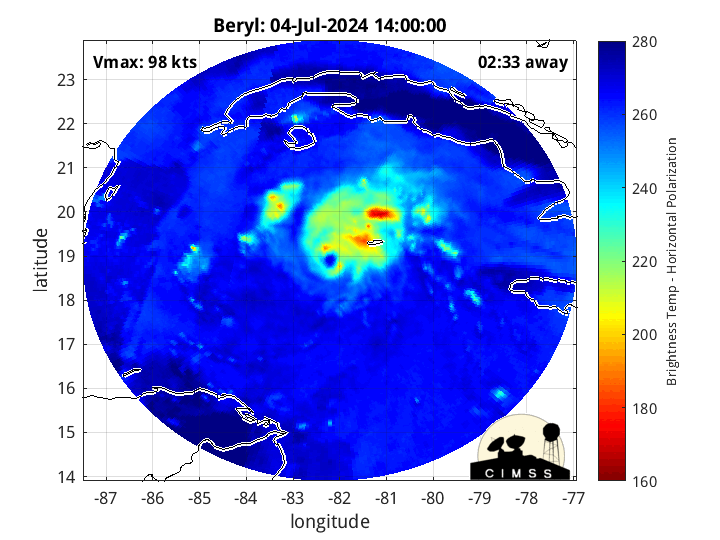
From CIRA (CSU):
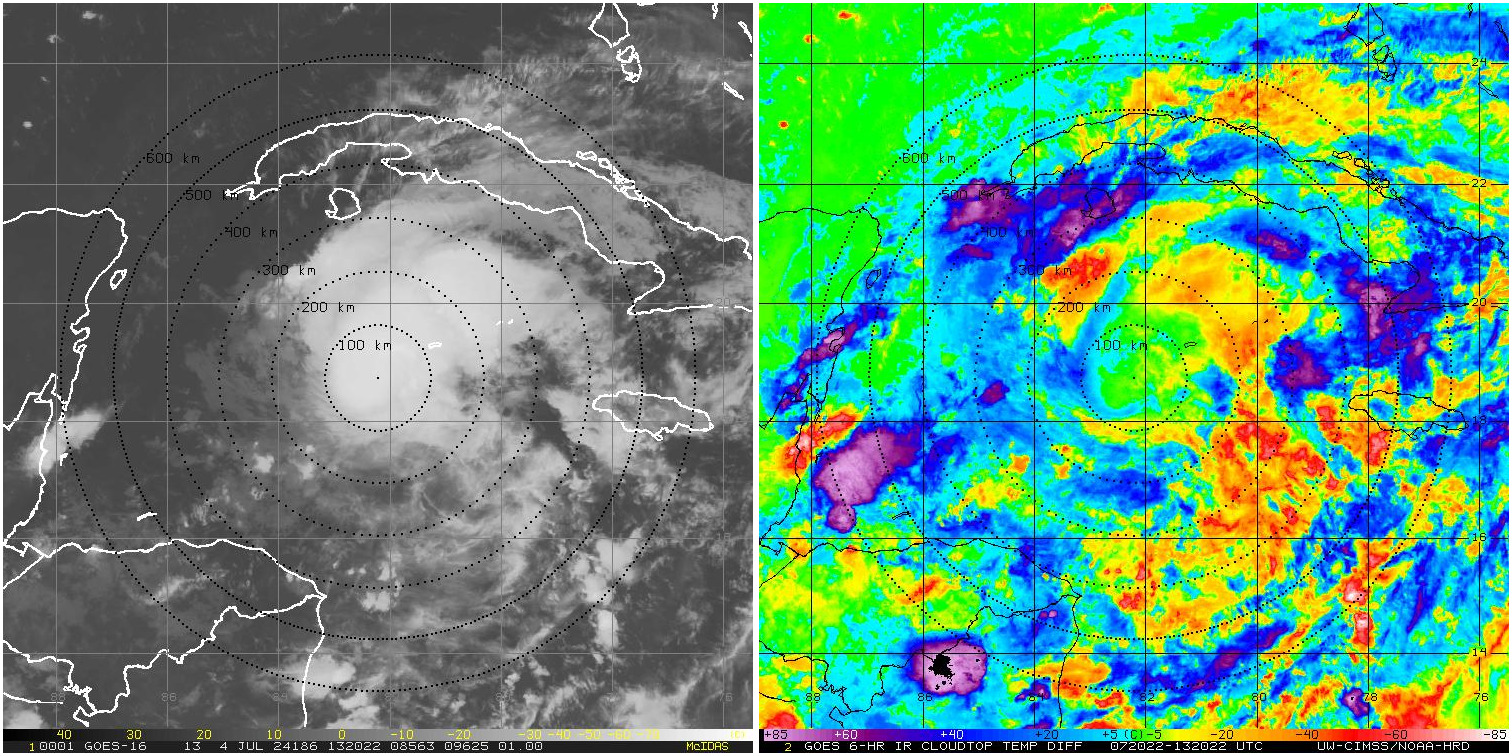
West to southwest shear increases dramatically over the Central Caribbean - 30-40+ mph:

The European 500mb forecast for Wed., 07/03 to Saturday, July 6th. Note the upper high shifting east allowing for an alleyway over the Western Gulf of Mexico:
A look into the eye 👁️ of Hurricane Beryl today. Late Monday, Beryl became the earliest storm to develop into a Category 5 hurricane in the Atlantic, though it was downgraded Tuesday to Category 4.
— Hurricane Hunters (@53rdWRS) July 2, 2024
For up to date forecasts visit https://t.co/96ZlCzpVcZ#hurricaneberyl pic.twitter.com/Dd81YzOuuM
Beryl’s wind trace shows the rapid intensification (IR) followed by a pause Sunday night during an eyewall replacement cycle (ERC) then the ramp up to Cat. 5 Mon. night into Tue. followed by the gradual decrease:
An aside: “Beryl” was an early season storm back in 2012 coming ashore in Duval Co. & metro Jacksonville, Florida just below hurricane strength during the weekend of Memorial Day.
:quality(70)/pbs.twimg.com/media/DeFjqSWW4AAIE7m.jpg)
(2) The next tropical wave - ‘96-L’ - come off the coast of Africa over the past weekend but with a decreasing chance for significant development... for now. This wave is following in the footsteps of Beryl but conditions become less favorable the more west this wave gets, & it’s possible this wave will struggle to develop much or at least to be able to maintain much organization. But there will be some gusty squalls through Thursday across the Lesser Antilles. This wave may still have long term potential once near or over the Western Gulf of Mexico next week. Stay up to date on this system for longer term development.
“Buresh Bottom Line”: * Beryl impacts the Caribbean this week... Jamaica & the Cayman Islands Wed.-Wed. night followed by the Yucatan Peninsula Thu. night/Fri. & then a turn more northwest, maybe N/NW from there over the Bay of Campeche & the far Western Gulf of Mexico over the weekend.
* The third wave - ‘96-L’ - may end up farther north than its two predecessors & will need to be monitored though environmental conditions appear to be marginal for much development in the longer range. But some forecast models do indicate the potential for some development once to the Western Gulf (sound familiar??).
Stay up to date on the latest forecasts....



REMEMBER WHEN A TROPICAL STORM OR HURRICANE IS APPROACHING: Taping windows is *not* recommended & will not keep glass from breaking. Instead close curtains & blinds.
Realize the forecast cone (”cone of uncertainty”) is the average forecast error over a given time - out to 5 days - & *does not* indicate the width of the storm &/or where damage might occur.

The upper oceanic heat content (UOHC) [tropical cyclone heat potential/TCHP] across the SW Atlantic, Gulf & Caribbean is unseasonably high for this time of year:






Water vapor loop (dark blue/yellow is dry mid & upper level air):


July tropical cyclone origins (early season breeding grounds are the Gulf &/or Western Caribbean:
Averages below based on climatology for the Atlantic Basin for July (1 hurricane so far, 3 tropical storms):
Wind shear (red - strong shear; green - low shear):



Saharan dust spreads west each year from Africa driven by the prevailing winds (from east to west over the Atlantic). Dry air = yellow/orange/red/pink. Widespread dust is indicative of dry air that *can* interfere with the development of tropical cyclones. However, sometimes “wanna’ be” waves will just wait until they get to the other side of - or away from - the dust plume then try to develop if other conditions are favorable. In my personal opinion, there is way too much “hoopla” about the presence of Saharan dust & how it relates to tropical cyclones. In any case, the peak of Saharan dust typically is in June & July.

2024 names..... “Debby” is the next name on the Atlantic list (names are picked at random by the World Meteorological Organization... repeat every 6 years). Historic storms are retired [Florence & Michael in ’18 (the last time this year’s list was used)... Dorian in ’19 & Laura, Eta & Iota in ‘20, Ida in ‘21 & Fiona & Ian in ‘22]). In fact, this year’s list of names is rather infamous because of the ‘04 season when Charley, Frances, Jeanne & Ivan - all retired names - hit Florida within a matter of about 6 weeks. The WMO decided - beginning in 2021 - that the Greek alphabet will be no longer used & instead there will be a supplemental list of names if the first list is exhausted (has only happened three times - 2005, 2020 & 2021). The naming of tropical cyclones began on a consistent basis in 1953. More on the history of naming tropical cyclones * here *.





East Atlantic:





Mid & upper level wind shear (enemy of tropical cyclones) analysis (CIMMS). The red lines indicate strong shear:
Water vapor imagery (dark blue indicates dry air):

Deep oceanic heat content over the Gulf, Caribbean & deep tropical Atlantic. The colors will brighten greatly as the water warms to greater depths deeper into the season:

Sea surface temp. anomalies:


SE U.S. surface map:

Surface analysis centered on the tropical Atlantic:

Surface analysis of the Gulf:

Caribbean:

Atlantic Basin wave period forecast for 24, 48, 72 & 96 hours respectively:




East & Central Pacific:





West Pacific:

Global tropical activity:



Cox Media Group

:quality(70)/cloudfront-us-east-1.images.arcpublishing.com/cmg/JIFG55NSN5HKZK6LKEZ4C7UU5I.jpg)
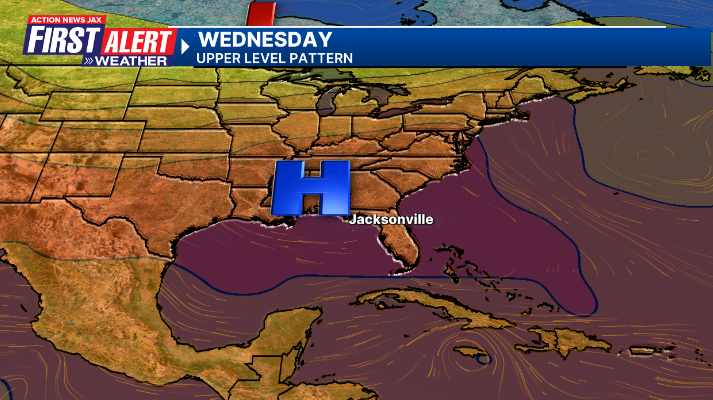
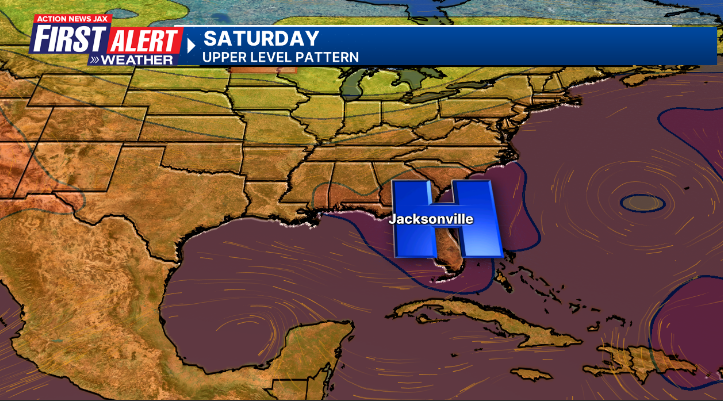
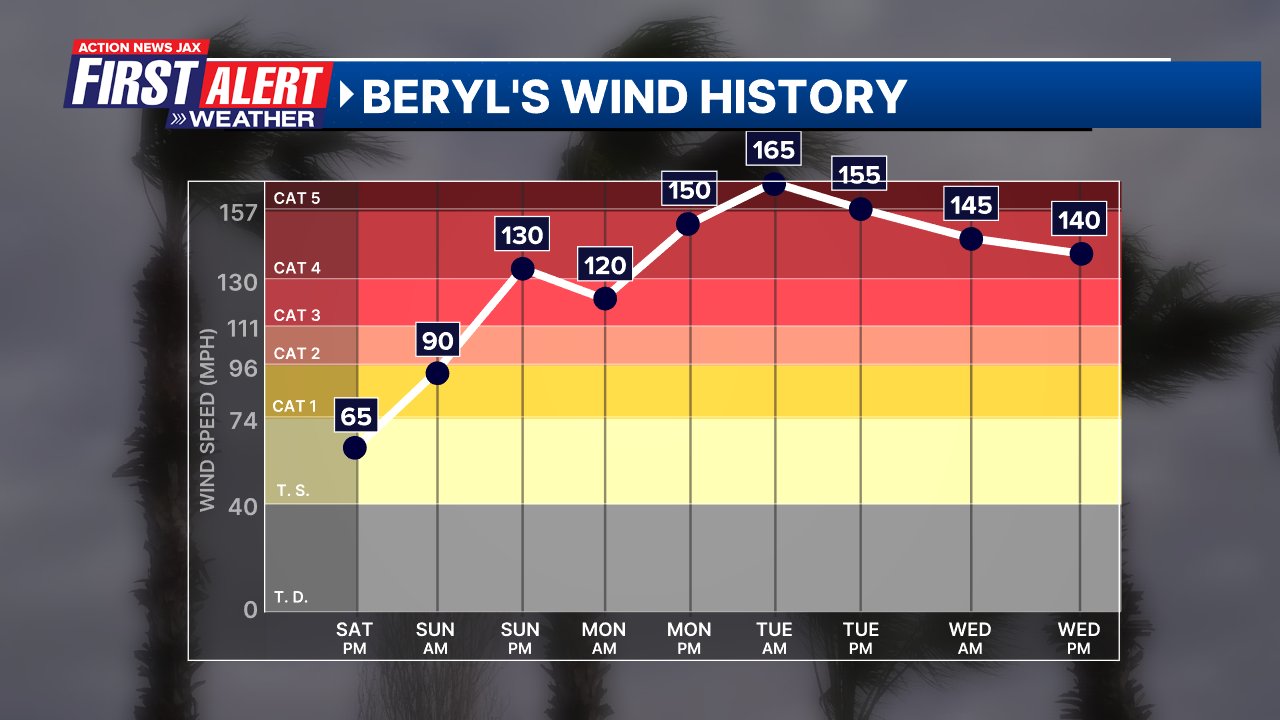

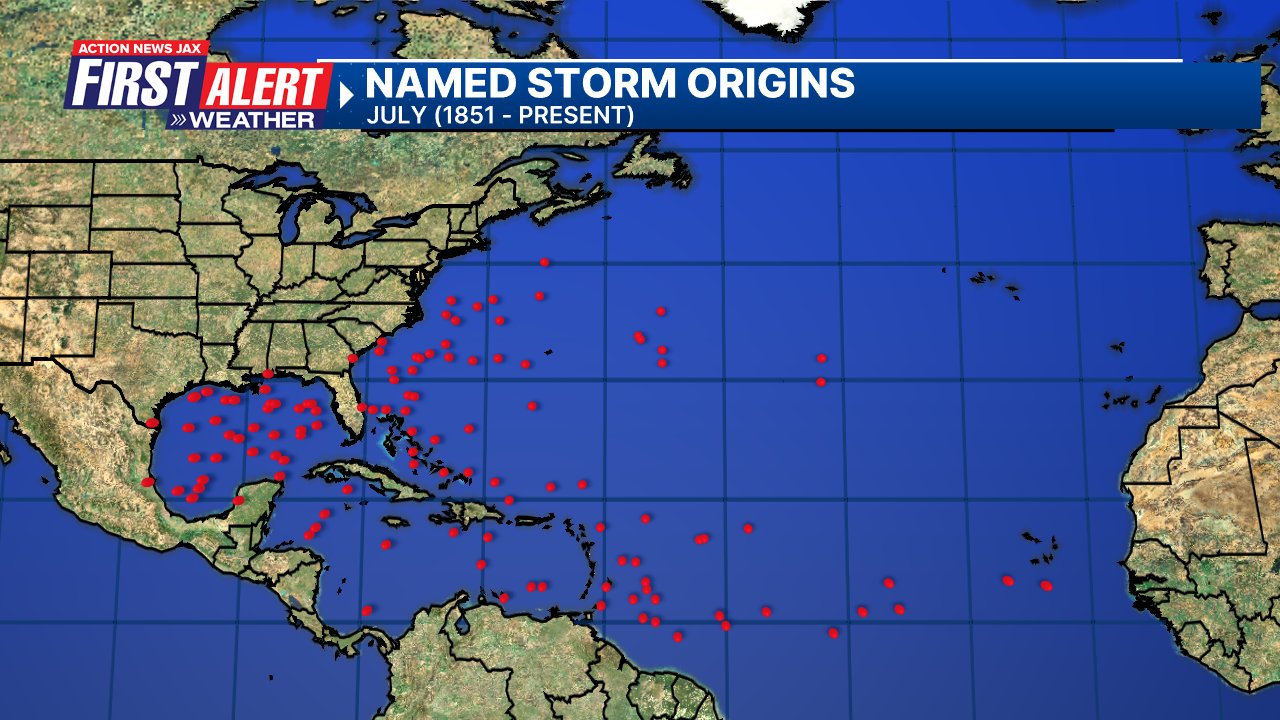

:quality(70)/cloudfront-us-east-1.images.arcpublishing.com/cmg/SKX4RKW645ERTATCLA4V2FVRKQ.png)
:quality(70)/cloudfront-us-east-1.images.arcpublishing.com/cmg/VFGNOWDMQRFUNDZYHRTIPEQYYQ.jpg)
:quality(70)/cloudfront-us-east-1.images.arcpublishing.com/cmg/SHM5VKGXUVFSNEJL6Z5QFC5VQY.jpg)
:quality(70)/cloudfront-us-east-1.images.arcpublishing.com/cmg/SCWUKX27NRFXVFR2KCQYQ3ZPQY.jpg)
:quality(70)/cloudfront-us-east-1.images.arcpublishing.com/cmg/WRPL7ID45NEP3EIWDB5YRKMIDY.PNG)
:quality(70)/cloudfront-us-east-1.images.arcpublishing.com/cmg/SNCUY732TTCV7RZKRMMPDKOILM.jpg)
:quality(70)/cloudfront-us-east-1.images.arcpublishing.com/cmg/Z6MRPVB6YSKC4NUK46CGWCKMKQ.jpg)
:quality(70)/cloudfront-us-east-1.images.arcpublishing.com/cmg/PKFY2SNHADVW5BQGI5O56BAOVQ.jpg)
